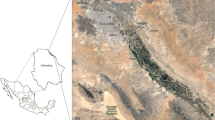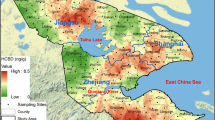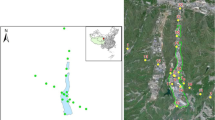Abstract
Background, aim, and scope
Lindane, technically 1, 2, 3, 4, 5, 6-hexachlorocyclohexane (γ- HCH), is the most commonly detected organochlorine pesticide from diverse environmental compartments. Currently, India is the largest consumer and producer of lindane in the world. The production of lindane results in the generation of large quantities of waste HCH isomers (mainly α-, β- and δ-). All these isomers are toxic and have a long-range environmental transport potential. The aim of this study was to monitor the seasonal variation of HCH isomers in an open soil–plant–rhizospheric soil system of a contaminated industrial area. For this, selected plant species and their rhizospheric soil (soil samples collected at a depth range of 0–45 cm near to the root system) and open soil samples (soil samples collected (0–30 cm depth) from 1–1.5 m away from the plant root system) were collected for 2 years (two summer seasons and two winter seasons).
Materials and methods
Seven plant species along with their rhizospheric soil and open soil samples were collected seasonally from different parts of the industry. Plant samples were separated into root, leaf and stem. HCH isomers in plant and soil samples were extracted by matrix solid-phase dispersion extraction (MSPD) and Soxhlet extraction, respectively, followed by GC-ECD. The seasonal difference in occurrence of HCH isomers in plant samples with their respective soil-system was studied by multivariate statistical approaches.
Results
The mean concentration of total HCH in plant samples, open soil and rhizospheric soil samples were found in the range of 14.12 to 59.29 mg kg−1; 38.64 to 104.18 mg kg−1 and 8.38 to 26.05 mg kg−1, respectively. Cluster grouping reveals that S. torvum and W. somnifera can accumulate more HCH than other studied species.
Discussion
There was a marked seasonal difference in the occurrence of HCH isomers in plant samples (p < 0.05) and open soil samples (p < 0.01). Comparatively higher levels of HCH isomers were detected from plant samples during summer, while higher levels of HCH isomers were detected from soil samples during the winter season. There was no significant difference in seasonal variation of HCH isomers in rhizospheric soil samples; however, total HCH in rhizospheric soil samples were 4 to 5-fold lower than the open soil samples. The total concentration of HCH isomers in roots is linearly related to their rhizospheric HCH level.
Conclusions
HCH isomers were detected in open soil, plants and rhizospheric soil samples. Monitoring studies clearly revealed that the above-mentioned industrial area is contaminated with all major isomers of HCH. Occurrence of all these isomers in the study area point out the lack of sustainable management practices of this industry for protecting the area from hazardous waste. The analytical results confirmed that accumulation depends upon the plant species, soil and climatic conditions.
Recommendations and perspectives
Recently, α-, β- and γ-HCH have been nominated by the POPs Reviewing Committee for inclusion into the Stockholm Convention to address the HCH contamination on a global level. Therefore, there is an urgent need to stop the production of lindane and remediate contaminated soil sites. Based on the monitoring studies, the promising species like W. somnifera and S. torvum may be selected for the on-site phytoremediation of HCH-contaminated soil. The mismanagement of HCH residues from the organochlorine industry and their contemporary relevance often after decades of their deposition is one key example demonstrating the necessity to evaluate the waste deposits of the respective organochlorine productions and need for a strict waste management, and the necessity of an integrated pollution prevention and control strategy for the whole organochlorine industry including also the developing countries.





Similar content being viewed by others
References
Abhilash PC (2009) Monitoring of organochlorine pesticide (Lindane) in soil-plant system of a contaminated environment and its phytoremediation/bioremediation. Ph D thesis, University of Lucknow, India
Abhilash PC, Singh N (2008a) Distribution of hexachlorocyclohexane isomers in soil samples from a small scale industrial area of Lucknow, North India, associated with lindane production. Chemosphere 73:1011–1015
Abhilash PC, Singh N (2008b) Multiple residue extraction for organochlorine pesticides in medicinal plants. Bull Environ Contam Toxicol 81:604–607
Abhilash PC, Singh N (2008c) Influence of the application of sugarcane bagasse on Lindane mobility through soil columns: implication for biotreatment. Bioresour Technol 99:8961–8966
Abhilash PC, Singh N (2009) Pesticide use and application: an Indian scenario. J Hazard Mat in press. doi:10.1016/j.jhazmat.2008.10.061
Abhilash PC, Jamil S, Singh N (2007) Matrix solid-phase dispersion extraction versus solid-phase extraction in the analysis of combined residues of hexachlorocyclohexane isomers in plant matrices. J Chromatogr A 1176:43–47
Abhilash PC, Jamil S, Singh V, Singh A, Singh N, Srivastava SC (2008) Occurrence and distribution of hexachlorocyclohexane isomers in vegetation samples from a contaminated area. Chemosphere 72:79–86
Abhilash PC, Singh V, Singh N (2009) Simplified determination of combined residues of Lindane and other HCH isomers in vegetables, fruits, wheat, pulses and medicinal plants by matrix solid phase dispersion (MSPD) followed by GC-ECD. Food Chem 113:267–271
Agnihotri NP, Kulshreshtha G, Gajbhiye VT, Mohapatra SP, Singh SB (1996) Organochlorine insecticide residues in agricultural soils of the Indo-gangetic plains. Environ Monit Asses 40:279–288
Anderson TA, Coats JR (1995) Screening rhizosphere soil samples for the ability to mineralize elevated concentrations of atrazine and metachlor. J Environ Sci Heal B 30:473–484
Anderson TA, Guthrie EA, Walton BT (1993) Bioremediation in the rhizopshere: plant roots and associated microbes clean contaminated soil. Environ Sci Technol 24:885–889
Andersson E, Rotander A, Kronhelm TV, Berggren A, Ivarsson P, Hollert H, Engwall M (2009) AhR agonist and genotoxicant bioavailability in a PAH-contaminated soil undergoing biological treatment. Environ Sci Pollut Res. doi:10.1007/s11356-009-0121-9
Bakore N, John PJ, Bhatnagar P (2004) Organochlorine pesticide residues in wheat and drinking water samples from Jaipur, Rajasthan, India. Environ Monit Assess 98:381–389
Bhattacharya B, Sarkar SK, Mukherjee N (2003) Organochlorine pesticide residues in sediments of a tropical mangrove estuary, India: implications for monitoring. Environ Int 29:587–592
Boltner D, Moreno-Morillas S, Ramos JL (2005) 16 S rDNA phylogeny and distribution of lin genes in novel hexachlorocyclohexane degrading Sphingomonas strains. Environ Microbiol 7:1329–1338
Calvelo-Pereira R, Camps-Arbestain M, Rodriguez Garrido B, Macias F, Monterroso C (2006) Behavior of α-, β-, γ–and δ-hexachlorocylcohexane in the soil-plant system of a contaminated site. Environ Pollut 144:210–217
Chaudhry Q, Blom-Zandstra M, Gupta S, Joner EJ (2005) Utilizing the synergy between plants and rhizosphere microorganisms to enhance breakdown of organic pollutants in the environment. Environ Sci Pollut Res 12:34–48
Concha-Grana E, Turnes-Carou MI, Muniategui-Lornzo S, Lopez-Mahia P, Prada-Rodriguez D, Fernandez-Fernandez E (2006) Evaluation of HCH isomers and metabolites in soils, leachates, river water and sediments of a highly contaminated area. Chemosphere 64:588–595
Cunningham SD, Anderson TA, Schwab AP, Hsu FS (1996) Phytoremediation of soils contaminated with organic pollutants. Advan Agronomy 56:55–64
Curl EA, Truelove B (1986) The rhizosphere. Springer, Heidelberg
Dadhwal M, Singh A, Prakash O, Gupta SK, Kumari K, Sharma P, Jit S, Verma M, Holliger C, Lal R (2008) Proposal of biostimulation for HCH decontamination and characterization of culturable bacterial community from high dose point HCH contaminated soils. J Appl Microbiol 106:381–392
Dadhwal M, Singh A, Lal R (2009) Evaluation of hexachlorocyclohexane contamination levels in the premises and vicinity of lindane production unit and HCH dumpsite. Chemosphere (submitted)
Darrah PR, Jones DL, Kirk GJD, Roose T (2006) Modelling the rhizosphere: a review of methods for up scaling to the whole plant scale. Europe J Soil Sci 57:13–25
Earth fax (2002) Fungal bioremediation of soils affected by a wood preservative. http://www.earthfax.com/Expertise/Environment_SoilContam.htm
Fielder H, Hub M, Hutzinger O (1995) Handbuch Altlasten, Bd. 9: Stoffbericht hexachlorocyclohexane (HCH). Landesanstalt fur Umweltschutz Baden-Württemberg
Holoubeck I, Korinek P, Seda Z, Scheiderova E, Holoubkova I, Pacl A, Triska J, Cudlin P, Caslavsky J (2000) The use of mosses and pine needles to detect persistent organic pollutants at local and regional scales. Environ Pollut 109:283–292
Iwata H, Tanabe S, Sakai N, Nishimura A, Tatsukawa R (1994) Geographical distribution of persistent organochlorines in air, water and sediments from Asia and Oceania, and their implications for global redistribution from lower latitudes. Environ Pollut 85:15–33
Jones HG (1992) Plants and microclimate: a quantitative approach to environmental plant physiology, 2nd edn. Cambridge University Press, Cambridge
Kalbitz K, Popp P (1999) Seasonal impacts on γ-hexachlorocyclohexane concentration in soil solution. Environ Pollut 106:139–141
Kidd PS, Prieto-Fernandez A, Monterroso C (2008) Rhizosphere microbial community and hexachlorocyclohexane degradative potential in contrasting plant species. Plant Soil 302:233–247
Krauthacker B, Romanica SH, Reiner E (2001) Polychlorinated biphenyls and organochlorine pesticides in vegetation samples collected in Croatia. B Environ Contam Tox 66:334–341
Krutz LJ, Beyrouty CA, Gentry TJ, Wolf DC, Reynolds CM (2005) Selective enrichment of a pyrene degrader population and enhanced pyrene degradation in Bermuda grass rhizosphere. Biol Fertil Soils 41:359–364
Kuiper I, Lagendijk EL, Bloemberg GV, Lugtenberg BJJ (2004) Rhizoremediation: a beneficial plant-microbe interaction. Mol Plant Microbe Interact 17:6–15
Kumari B, Singh J, Singh S, Kathpal TS (2005) Monitoring of butter and ghee (clarified butter fat) for pesticide contamination from cotton belt of Haryana, India. Environ Monit Asses 105:11–120
Kumari B, Madan VK, Kathpal TS (2006) Monitoring of pesticide residues in fruits. Environ Monit Asses 123:407–412
Kylin H, Grimvall E, Ostman C (1994) Environmental monitoring of polychlorinated biphenyls using pine needles as passive samplers. Environ Sci Technol 28:1320–1324
Lal R, Dadhwal M, Kumari K, Sharma P, Singh A, Kumari H, Jit S, Gupta SK, Lal D, Verma M, Kaur J, Bala K, Jindal S (2008) Pseudomonas sp to Sphingobium indicum: a journey of microbial degradation and bioremediation of hexachlorocyclohexane. Indian J Microbiol 48:3–18
Li YF (1999) Global technical hexachlorocyclohexane (HCH) usage and its contamination consequences in the environment: from 1948 to 1997. Sci Total Environ 232:121–158
Manz M, Wenzel K-D, Dietze Schuurmann U (2001) Persistent organic pollutants in agricultural soils of central Germany. Sci Total Environ 277:187–198
Mathur HB, Johnson S, Singh B, Mishra R, Kumar A (2003) Bottled water has pesticide residue. Down Earth 11:27–33. http://www.cseindia.org/html/lab/bottledwaterresult.htm
Mohan WW, Mertens B, Neufeld JD, Verstraete W, de Lorenzo V (2006) Distribution and phylogeny of hexachlorocyclohexane degrading bacteria in soils from Spain. Environ Microbiol 8:60–68
Oliveira RM, Bastos LH, Dias AE, Silva SA, Moreira JC (2003) Residual concentration of hexachlorocyclohexane in a contaminated site in Cidade dos Meninos, Duque de Caxias, Rio de Janeiro, Brazil, after calcium oxide treatment. Cad Saude Publica 19:447–453
Pandit GG, Sahu SK (2002) Assessment of risk to public health posed by persistent organochlorine pesticide residue in milk and milk products in Mumbai, India. J Environ Monit 4:182–185
Philips TM, Seech AG, Lee H, Trevors JT (2005) Biodegradation of hexachlorocyclohexane (HCH) by microorganisms. Biodegradation 16:363–392
Philips TM, Lee H, Trevors JT, Seech AG (2006) Full scale in situ bioremediation of hexachlorocyclohexane-contaminated soil. J Chem Technol Biotechnol 81:289–298
Prakash O, Suar M, Raina V, Dogra C, Pal R, Lal R (2004) Residues of Hexachlorocyclohexane (HCH) Isomers from different Soil and water samples in Delhi and Adjoining Areas. Curr Sci 87:73–77
Raina V, Hauser A, Buser HR, Rentsch D, Sharma P, Lal R, Holliger C, Poiger T, Müller MD, Kohler HP–E (2007) Hydroxylated metabolites of b- and d-hexachlorocyclohexane: bacterial formation, stereochemical configuration, and occurrence in groundwater at a former production site. Environ Sci Technol 41:4292–4298
Raina V, Rentsch D, Geiger T, Sharma P, Buser HR, Holliger C, Lal R, Kohler HP-E (2008) J Agric Food Chem 56:6594–6603
Sharma RK, Agrawal M, Marshall F (2007) Heavy metal contamination of soil and vegetables in suburban areas of Varanasi, India. Ecotoxicol Environ Safety 66:258–266
Sievers S, Friesel P (1989) Soil contamination patterns of chlorinated organic compounds: looking for the source. Chemosphere 19:691–698
Simonich SL, Hitéis RA (1995) Organic pollutants accumulation in vegetation. Environ Sci Technol 29:2905–2914
Singh KP, Malik A, Sinha S (2007) Persistent organochlorine pesticide residues in soil and surface water of northern Indo-Gangetic plains. Environ Monit Assess 125:147–155
USEPA (1980) Lindane position document 2/3, Report of the US Environmental Protection Agency, 540/9-87-153, Washington, DC
Vega FA, Covelo EF, Andrade ML (2007) Accidental organochlorine pesticide contamination of soil in Porrino, Spain. J Environ Qual 36:272–279
Vijgen J (2006). The Legacy of Lindane HCH Isomer Production, http://ew.eea.europa.eu/Agriculture/Agreports/obsolete_pesticides/lindane_production.pdf/
Vijgen J, Li YF, Martin F, Lal R, Weber R (2006) The legacy of lindane and technical HCH production. Organohal Comp 68:899–904
Walker K, Vallero DA, Lewis RG (1999) Factors influencing the distribution of lindane and other hexachlorocyclohexanes in the environment. Environ Sci Technol 33:4373–4378
Weber R, Behnisch PA, Brouwer A, van Bavel B, Lindstroem G, Zennegg M, Schilling B, Paepke O (2006) Contemporary relevance of dioxin and dioxin-like compound contaminations in residues from recycling of HCH waste. Organohalogen Comp 68:905–910
Weber R, Gaus C, Tysklind M, Johnston P, Forter M, Hollert H, Heinisch H, Holoubek I, Lloyd-Smith M, Masunaga S, Moccarelli P, Santillo D, Seike N, Symons R, Torres JPM, Verta M, Varbelow G, Vijgen J, Watson A, Costner P, Woelz J, Wycisk P, Zennegg M (2008a) Dioxin- and POP-contaminated sites - contemporary and future relevance and challenges. Environ Sci Pollut Res 15:363–393
Weber R, Tysklind M, Gaus C (2008b) Dioxin—contemporary and future challenges of historical legacies (Editorial). Environ Sci Pollut Res 15:96–112
Willet KL, Utrich EM, Hites RA (1998) Differential toxicity and environmental facts of heaxchlorocyclohexane isomers. Environ Sci Technol 32:2197–2207
Wu WZ, Xu Y, Schramn KW, Kettrup A (1997) Study of adsorption, bio-degradation and isomerization of HCH in stimulated sediment/water system. Chemosphere 35:1887–1894
Wycisk P, Weiss H, Kaschl A, Heidrich S, Sommer-Werk K (2003) Groundwater pollution and remediation options for multi-source contaminated aquifers (Bitterfeld/Wolfen, Germany). Toxicol Letters 140–141:343–351
CAPE (Community Action for Pesticide Elimination), Lindane’s dirty secret: Indian facilities dump toxic waste. http://www.panna.org/campaigns/docsLindane/lindaneDirtySecret.pdf
Acknowledgements
Authors are grateful to the Director of the National Botanical Research Institute for providing facilities. Financial help from CSIR for Task Force Project (SMM-05) is thankfully acknowledged. Authors would like to thank Prof. Alvin Young, Dr. Lee Young and Prof. Roland Weber and two anonymous reviewers for their valuable suggestions and critical evaluation of this manuscript. Thanks are also due to Vandana Singh, PA for analytical help and Ram Naresh, Lab Assistant for field work. P.C. Abhilash is thankful to the University Grants Commission, Government of India for Doctoral Fellowship (UGC-JRF-SRF).
Author information
Authors and Affiliations
Corresponding author
Additional information
Responsible editor: Roland Weber
Rights and permissions
About this article
Cite this article
Abhilash, P.C., Singh, N. Seasonal variation of HCH isomers in open soil and plant-rhizospheric soil system of a contaminated environment. Environ Sci Pollut Res 16, 727–740 (2009). https://doi.org/10.1007/s11356-009-0133-5
Received:
Accepted:
Published:
Issue Date:
DOI: https://doi.org/10.1007/s11356-009-0133-5




